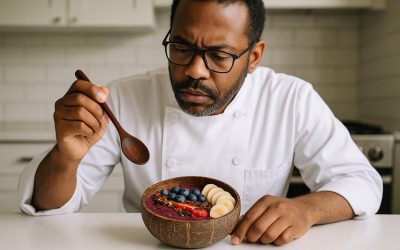Dive into the World of Sushi: Explore the Origins, Ingredients, and Preparation of the Iconic California Roll.
As an Amazon Associate I earn from qualifying purchases.
The humble sushi, with its origins in ancient Southeast Asia and refined culinary traditions in Japan, has remarkably found its way into the global gastronomic scene. And among the myriad of sushi varieties now gracing menus worldwide, the California roll stands out, not just for its flavor, but for its unique cultural and culinary significance. This iconic roll, with its colorful palette of creamy avocado, crunchy cucumber, and often, the rich tones of imitation crab, wrapped in glistening sushi rice and crisp nori, embodies a story of innovation, fusion, and adaptation. In this article, we’ll journey back to 1960s Los Angeles, where the California roll was born, and explore the nuanced interplay of East meets West that transformed sushi from an exotic delicacy to a global sensation. Dive in as we unwrap the layers of the California roll, a symbol of culinary evolution and the universal appeal of good food.
Most Recommended Sushi Rice
———
Table of Contents
———
…
The Secret Ingredients to Perfect Recipes
No products found.
California Roll
The California roll is a classic sushi roll that’s beloved by many. It’s perfect for those who might be a bit hesitant about diving straight into traditional sushi, as it doesn’t contain raw fish. Here’s a simple California roll recipe:
Ingredients:
Sushi Rice:
- 2 cups sushi rice (short grain rice)
- 2 ½ cups water
- 1/3 cup rice vinegar
- 3 tablespoons sugar
- 1 teaspoon salt
Filling and Wrapping:
- Nori (seaweed) sheets
- 1 avocado, sliced thinly
- 1 cucumber, julienned or thinly sliced (seedless or seeds removed)
- Imitation crab sticks (or real crab meat, if preferred)
- Toasted sesame seeds (optional)
- Soy sauce, for serving
Additional Tools:
- Bamboo sushi rolling mat
- Sharp knife
- Plastic wrap (helpful for keeping the bamboo mat clean)
Instructions:
Prepare Sushi Rice:
- Rinse the rice under cold water until the water runs clear. This removes excess starch and helps you get the sticky consistency.
- In a rice cooker or pot, cook the rice with the water.
- While the rice is cooking, heat the rice vinegar, sugar, and salt in a small saucepan over low heat until the sugar dissolves. Cool the mixture.
- Once the rice is cooked, transfer it to a large bowl. While it’s still hot, gently fold in the vinegar mixture using a wooden spatula. Allow the rice to cool to room temperature.
Roll the Sushi:
- Place the bamboo mat on a flat surface. You can wrap it in plastic wrap to make cleanup easier.
- Lay a sheet of nori on the bamboo mat.
- Wet your fingers (this prevents sticking) and spread a thin layer of sushi rice onto the nori, leaving about ½ inch at the top edge free of rice.
- Sprinkle the rice with sesame seeds if desired.
- Lay a few pieces of avocado, cucumber, and crab sticks horizontally across the center of the rice.
- Starting at the bottom, carefully roll the sushi using the bamboo mat, pressing gently but firmly to make sure it rolls tightly.
- Using a sharp, wet knife, slice the roll into bite-sized pieces.
Serve:
- Serve the California roll slices with soy sauce and any other desired accompaniments like pickled ginger or wasabi.
Enjoy your homemade California rolls! Adjust ingredients to your preference, and with practice, you’ll be able to whip up this delightful sushi in no time.
TIPS:
Crafting the perfect California roll can be both fun and rewarding. Here are some expert tips to help you make the best California roll:
- Rice Consistency: The key to a good sushi roll is the rice. Ensure that your sushi rice is neither too wet nor too dry. When cooked, it should be sticky but still retain individual grain integrity.
- Season the Rice Properly: Don’t skip the step of seasoning your rice with the vinegar-sugar-salt mixture. This gives the rice its distinct sushi flavor and shine.
- Rice Temperature: Use the rice when it’s cooled to room temperature. If it’s too hot, it will wilt the nori. If it’s too cold, it won’t spread well.
- Use Sharp Knives: When cutting your sushi roll, use a sharp knife and always wet the blade with a damp cloth or water. This ensures smooth, clean cuts without squishing the roll.
- Rolling Technique: Apply even pressure when rolling using the bamboo mat to ensure the roll is tight and maintains its shape. However, don’t press so hard that the filling gets crushed or squeezed out.
- Nori Placement: Traditionally, the rice goes on top of the nori in a California roll, but you can also make it with the rice inside and the nori on the outside for a different look and texture.
- Filling Quantity: Don’t overfill the roll; it will make it difficult to roll and may end up messy. A rule of thumb is to fill only about 1/3 of the nori sheet with your filling ingredients.
- Fresh Ingredients: Always use fresh ingredients, especially the avocado. A ripe but firm avocado works best.
- Variations: While the classic California roll uses imitation crab, feel free to substitute with real crab meat or even cooked shrimp for a different twist.
- Presentation: When presenting your rolls, arrange them on a plate with some pickled ginger, wasabi, and soy sauce on the side. Garnish with some sesame seeds or chives for added visual appeal.
- Storage: Sushi, especially rolls with avocado, is best consumed the day it’s made. The rice can become hard and the avocado brown if stored for too long. If you must store it, wrap it tightly in plastic wrap and consume it within 24 hours.
- Practice Makes Perfect: Rolling sushi is an art, and the more you do it, the better you’ll get. Don’t be discouraged if your first few rolls aren’t perfect; with practice, you’ll refine your technique!
Remember, the beauty of making sushi at home is the freedom to customize and experiment. Enjoy the process, and happy rolling!
Why This Recipe Is Just So Good…
The California roll, a delightful fusion of East meets West, has found its way into the hearts (and stomachs) of sushi enthusiasts and novices alike. But what makes this recipe resonate so deeply with its audience? Let’s explore:
- Accessible Ingredients: Unlike some sushi varieties that require raw fish, the California roll is made with ingredients that are easily accessible, like avocado, cucumber, and imitation crab. This universality means that even those hesitant about traditional sushi can still enjoy it.
- Creamy and Crunchy Texture: The ripe avocado provides a creamy texture, which contrasts beautifully with the crunchy, fresh cucumber. This interplay of textures makes every bite a delightful experience.
- Sweet and Savory Balance: The imitation crab, often sweetened, offers a gentle sweetness which pairs harmoniously with the savory notes of the seaweed and seasoned rice.
- Nutritional Value: Avocado is packed with healthy fats and vital nutrients, while cucumber offers hydration and freshness. Even the rice, seasoned with vinegar, has its own health benefits, providing quick energy.
- Versatility: The California roll is a great base for experimentation. One can add or substitute ingredients to their liking, such as using real crab meat, adding spicy mayo, or even sprinkling sesame seeds or tobiko (fish roe) on top.
- Visual Appeal: The combination of the white rice, green avocado, pinkish crab, and the deep green nori creates a visual treat that is almost as delightful as its taste.
- Cultural Fusion: The California roll is a testament to culinary innovation. Born in Los Angeles in the 1960s, it’s a beautiful example of how traditional Japanese techniques can meld with American tastes to create something entirely new and exciting.
- Perfect for Beginners: For those new to the world of sushi, the California roll acts as a gentle introduction, providing familiar flavors and textures.
In essence, the California roll is not just a dish; it’s an experience. Every bite is a celebration of taste, texture, and culinary innovation, making it no wonder why this recipe continues to be a global favorite.
Storage Instructions
Storing a California roll properly is essential to maintain its taste, texture, and safety. Here are some storage instructions to ensure that your California roll remains fresh for as long as possible:
Immediate Consumption is Best:
- Due to the nature of the ingredients, especially the avocado which can brown and change texture, California rolls are best consumed immediately after preparation.
Short-term Storage:
- If you need to store the rolls for a few hours before consumption, keep them in a cool place but not directly in the fridge, as the cold can make the rice harden and lose its pleasant texture.
- If storing for more than a couple of hours, place them in the refrigerator.
Refrigeration:
- If you’ve prepared California rolls in advance or have leftovers, wrap them tightly in plastic wrap or place them in an airtight container to prevent them from drying out. This can also help reduce the speed at which the avocado browns.
- Store in the refrigerator for up to 24 hours. Beyond this, the avocado may become too brown, and the rice may become too hard, affecting the overall quality.
- Avoid Freezing: It’s generally not recommended to freeze California rolls. Freezing can significantly alter the texture of the rice and the avocado, making them less enjoyable when thawed.
Check Before Consuming:
- If you’ve stored the rolls in the refrigerator for some time, check the avocado’s color and texture before consuming. If it has turned dark brown and mushy, it’s best to discard the roll.
Reviving the Rice:
- If you find that the rice has become a bit hard from refrigeration, you can lightly microwave the roll for a few seconds (10-15 seconds). However, this is a last resort and might not bring back the original texture entirely.
Add-ons and Dips:
- If you’ve served your California roll with any dips or sauces, like soy sauce, wasabi, or pickled ginger, store these separately in their original containers in the refrigerator.
Remember, fresh is always best when it comes to sushi, including California rolls. While you can store them for a short period, try to enjoy them as soon as possible after preparation for the best taste and texture experience.
Frequently Asked Questions (FAQ)
Here are some common questions and their answers regarding the California roll:
Q: What’s in a California roll?
A: A traditional California roll contains imitation crab (or sometimes real crab meat), avocado, and cucumber. It’s wrapped with sushi rice and nori (seaweed sheet). Some variations might include sesame seeds or tobiko (fish roe) on the outside.
Q: Is there raw fish in a California roll?
A: No, a standard California roll does not contain any raw fish. The “crab” is typically imitation crab made from cooked fish.
Q: Why is it called a California roll?
A: The California roll is believed to have been created in Los Angeles, California, in the 1960s. It was named after the state due to its origin and its adaptation to Western tastes.
Q: Are California rolls healthy?
A: California rolls can be a healthy choice when consumed in moderation. They provide protein from the crab, healthy fats from the avocado, and carbohydrates from the rice. However, like all foods, it’s essential to consider portion sizes and overall diet.
Q: Can I use real crab meat instead of imitation crab?
A: Yes, you can use real crab meat for a more authentic and luxurious taste. Ensure the crab meat is fresh and appropriately prepared.
Q: Why has my avocado turned brown in the roll?
A: Avocado oxidizes and turns brown when exposed to air. While it’s generally safe to eat, it might not look as appetizing. To reduce browning, use ripe but firm avocados and consume the roll soon after preparation.
Q: Can I make a vegan California roll?
A: Absolutely! You can replace the imitation crab with tofu, tempeh, or other vegan alternatives. Ensure all other ingredients and accompaniments are vegan-friendly.
Q: How do I store leftover California rolls?
A: Wrap the rolls tightly in plastic wrap or place them in an airtight container. Store in the refrigerator for up to 24 hours. However, they are best consumed fresh.
Q: Why is my sushi rice not sticky?
A: Sushi rice needs to be seasoned with a mix of rice vinegar, sugar, and salt to get its sticky texture. Ensure you’re using short-grain sushi rice and that you’ve rinsed it well before cooking.
Q: How can I make a spicy California roll?
A: You can add a drizzle of spicy mayo (a mix of mayonnaise and sriracha) over the crab or on top of the roll. Alternatively, include thin slices of jalapeño or other spicy peppers in the filling.
Q: How does the California roll fit within the broader history of sushi’s globalization?
A: The California roll is a paramount example of sushi’s adaptation to Western tastes, specifically those of the United States. It was innovatively designed in the 1960s, presumably in Los Angeles, as sushi chefs experimented to cater to the local palate. Removing traditional ingredients like raw fish and introducing familiar flavors like avocado and crab made sushi more approachable to Americans. This adaptation played a crucial role in popularizing sushi in the U.S. and, by extension, worldwide.
Q: Why is imitation crab often used instead of real crab in California rolls?
A: Imitation crab, or “surimi”, is made from white fish that’s been processed and flavored to resemble crab meat. It’s cost-effective, has a longer shelf life, and offers a consistent taste and texture compared to real crab meat. Moreover, it caters to a broader audience, some of whom might be hesitant to try raw ingredients or more authentic Japanese flavors.
Q: How does the rice’s seasoning in a California roll compare to traditional Edomae sushi from Tokyo?
A: While both California roll and Edomae sushi use a mix of rice vinegar, sugar, and salt to season the rice, the exact proportions can vary. Edomae sushi often emphasizes a more delicate balance to complement the flavors of fresh, local fish, whereas the rice in a California roll may have a slightly stronger seasoning to match the robust flavors of avocado, crab, and cucumber.
Q: Is there a specific technique to prevent the avocado from browning quickly in a California roll?
A: Avocado browns due to oxidation. To slow down this process, choose a ripe yet firm avocado. Some chefs also recommend drizzling a bit of lemon or lime juice on the avocado slices before adding them to the roll, as the citric acid can help prevent oxidation.
Q: How do the texture dynamics of a California roll compare to more traditional sushi rolls?
A: Traditional sushi rolls or nigiri often prioritize the freshness and texture of the raw fish. In contrast, a California roll plays with a broader range of textures: the creamy avocado, the crunchy cucumber, and the soft yet slightly chewy imitation crab. This complexity makes the California roll a multi-layered experience in terms of mouthfeel.
Q: What’s the significance of rolling the California roll “inside-out” with rice on the outside?
A: The “inside-out” roll, or “uramaki”, with rice on the outside was a deviation from traditional sushi rolls. It’s believed this adaptation was made both for aesthetic reasons and to cater to those who might be hesitant about the seaweed’s taste and texture. With the rice outside, the roll also provides an opportunity to add additional elements, like sesame seeds or tobiko, enhancing flavor and visual appeal.
Q: Can the balance of umami be enhanced in a California roll?
A: Absolutely! Umami can be intensified by using real crab meat or adding a light brush of soy sauce over the roll. Some chefs also incorporate a touch of wasabi or use seasoned sesame seeds to bolster the roll’s depth of flavor.
These answers reflect a deeper understanding of the California roll’s place in sushi’s global journey and the intricate balance of flavors and techniques that make it so beloved.
Conclusion
In the vast tapestry of global cuisine, few dishes capture the spirit of innovation and cultural amalgamation as vividly as the California roll. From its inception in the bustling kitchens of 1960s Los Angeles to its ubiquity in sushi bars and supermarket aisles worldwide, this roll has served as a bridge, connecting wary newcomers to the intricate world of sushi and providing seasoned aficionados with a fresh twist on tradition. Through its harmonious blend of ingredients, the California roll narrates a tale of culinary adaptability, proving that even deeply-rooted traditions can evolve and resonate universally. As we relish each bite, we’re not just savoring a delightful mix of flavors and textures; we’re celebrating the power of food to transcend borders, redefine norms, and bring people together. The California roll’s journey from West Coast innovation to global favorite is a testament to the boundless creativity of chefs and the ever-evolving palate of the global diner.


















